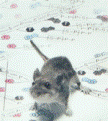Papers in the Biological Sciences

Jay F. Storz Publications
Document Type
Article
Date of this Version
2014
Citation
Genome Biol. Evol. 6(5):1219–1233. doi:10.1093/gbe/evu097.
Abstract
The evolutionary fate of chimeric fusion genes may be strongly influenced by their recombinational mode of origin and the nature of functional divergence between the parental genes. In the β-globin gene family of placental mammals, the two postnatally expressed δ- and β-globin genes (HBD and HBB, respectively) have a propensity for recombinational exchange via gene conversion and unequal crossing-over. In the latter case, there are good reasons to expect differences in retention rates for the reciprocal HBB/HBD and HBD/ HBB fusion genes due to thalassemia pathologies associated with the HBD/HBB “Lepore” deletion mutant in humans.Here,were port a comparative genomic analysis of the mammalian β-globin gene cluster, which revealed that chimeric HBB/HBD fusion genes originated independently in four separate lineages of laurasiatherian mammals: Eulipotyphlans (shrews, moles, and hedgehogs), carnivores, microchiropteran bats, and cetaceans. In cases where an independently derived “anti-Lepore” duplication mutant has become fixed, the parental HBD and/or HBB genes have typically been inactivated or deleted, so that the newly created HBB/HBD fusion gene is primarily responsible for synthesizing the β-type subunits of adult and fetal hemoglobin (Hb). Contrary to conventional wisdom that the HBD gene is a vestigial relict that is typically inactivated or expressed at negligible levels,we show that HBD-like genes often encode a substantial fraction (20–100%) of β-chain Hbs in laurasiatherian taxa. Our results indicate that the ascendancy or resuscitation of genes with HBD-like coding sequence requires the secondary acquisition of HBB-like promoter sequence via unequal crossing-over or interparalog gene conversion.


Comments
This is an Open Access article distributed under the terms of the Creative Commons Attribution Non-Commercial License.